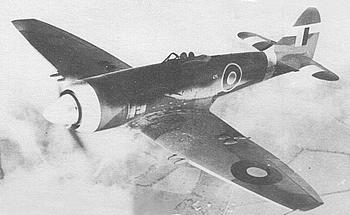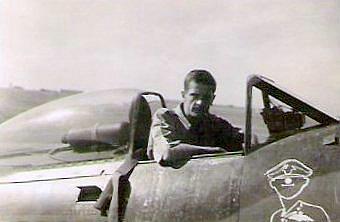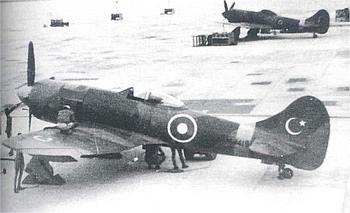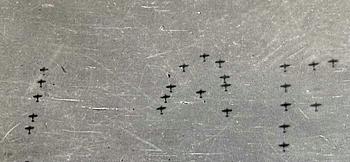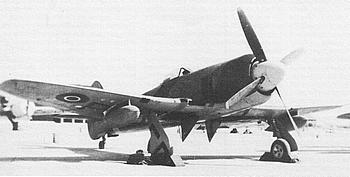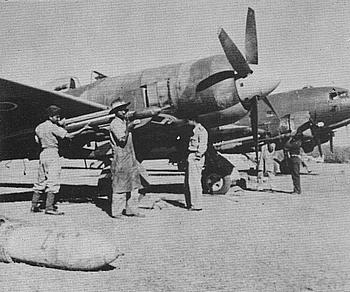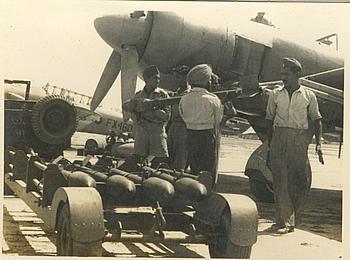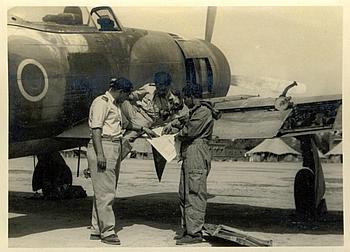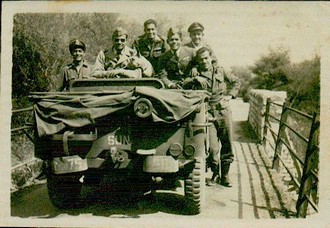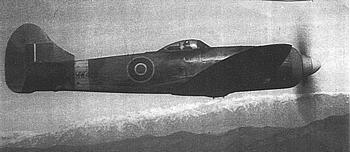THE TEMPERAMENTAL TEMPEST
A brief history of the IAF’s first true Fighter Bomber
“And from the earth, the sky, the winds, he felt the powers flowing anew. It had begun. The Tempest”
“The Tempest”, William Shakespeare
POLLY SINGH
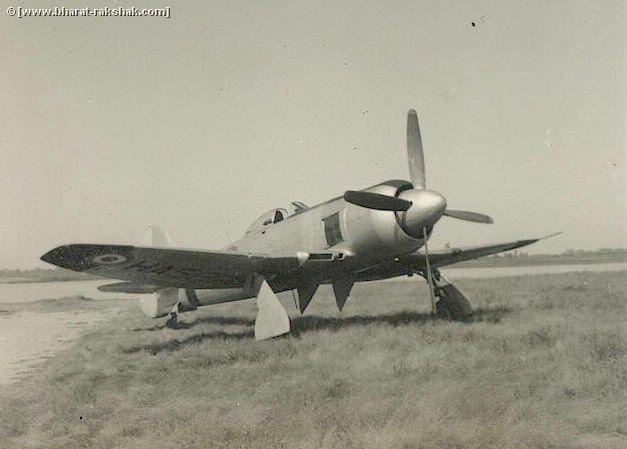 |
| A classic composition of a CTU Tempest II, HA 532 at Ambala. Picture courtesy: Air Mshl (Retd) S Raghavendran |
It has been exactly a half century since the Tempest howled through Indian skies. The last Tempests stood down in Sep 1955, when the Target Towing Flight under the Armament Training Wing (ATW) at Jamnagar handed in their four aircraft in exchange for Toofanis (MD 450 Ouragons). The Tempest formed the backbone of the IAF’s fighter fleet and almost single handedly dominated the critical ground support role during the1947- 48 conflict in Jammu and Kashmir. In its later career the Tempest II also played an important part in introducing young fighter pilots to fighter flying in what was certainly the’ biggest beast of a fighter aircraft’ at the time. Hastily developed for a very specialized ground attack role towards the end of WW II, the Tempest II had outlived its enabling technologies and was rapidly overtaken by the Meteor and Vampire jets by the end of 1948. With a manufacturer unwilling and then unable to support the aircraft’s great proclivity for frequent spares supply, the Tempest II became increasingly difficult to maintain. Severe and fundamental problems with the revolutionary Centaurus engine’s sleeve valve bearings led to a high engine – related accident rate in the IAF. In fact, during the Kashmir conflict the number of engine related non combat loses were of a much greater concern than actual combat related ones. This, coupled with a generally higher than average level of skill required to operate the aircraft, caused the Tempest II to be finally withdrawn from service in less than nine years. In fact the Tempest II was replaced in 7 Squadron by the earlier Spitfire XVIIIs and then by a slew of jet aircraft like the Vampire and Toofani (MD 450 Ouragon).
Typhoon/Tempest Development.
The Tempest was a development of the earlier, controversial but effective Hawker Typhoon of tank busting fame. The Typhoon began life even as the Hawker Hurricane was just entering RAF service in 1937. Hawker’s chief designer, the famous Sydney Camm based his preliminary design on two revolutionary 24-cylinder engines that promised to give twice the power of the then current 1030 hp Merlin engine. These were the Rolls Royce Vulture based on the combination of two Peregrine engines in an ‘X’ layout and the Napier Sabre which favoured the ‘H’ layout based on four banks of cylinders driving two crankshafts. Construction against the Air Ministry Specification F.18/37 began in Mar 1938 of two prototypes – the Tornado with the Vulture engine and the Typhoon with the Sabre (all Hawker aircraft followed the trend of being named in the ‘winds’ theme). Based on the potential of the two fighters an order for a 1000 aircraft with a mix of Tornados and Typhoon was placed in Mar 1940 but with the requirement of resources being concentrated for the manufacture of the Spitfire, Hurricane, Whitley, Wellington and the Blenheim at the time, production plans were postponed. In the meantime the Vulture on the Avro Manchester suffered a disastrous number of engine failures (with the Manchester being taken off operations) and the production of the engine was terminated following which the Tornado contract was cancelled. However before the Tornado project was scrapped one aircraft was fitted with a third new engine-the 2210hp, 18 cylinder, air cooled radial Bristol Centaurus. This sole test bed gave valuable service as the test bed for use of the engine on the Tempest II and its development, the Sea Fury. In the meantime the Typhoon, in spite of severe problems with the Sabre engine, lesser maneuverability than the Spitfire, but greater top speed (approx 40 mph above 14,000′) was entering service with No 56 Squadron as the only fighter to match the Luftwaffe’s Focke-Wulf FW 190. Initially without a suitable RAF role and with manufactures trying to desperately develop the airframe and engine into a reliable combination, the Typhoon emerged as the very epitome of close air support on the continent. Yet the aircraft served in no other theater, and with no air force except the RAF. Too specialized for a peacetime air force, the last Typhoon squadrons had disbanded by Sep 1945.
The Tempest is Born.
Early in the Typhoon development programme the wing had been identified as a major limitation on the aircraft’s performance. To overcome these deficiencies, the maximum depth of the wing was shifted back from 30 % to 37.5% MAC. The fineness ratio was also reduced to 14.5% at the root and the plan form was also changed to a semi-elliptical one not unlike the Spitfire’s. The new thin wing meant that part of the fuel stored in the wing had to be relocated in a new 21 inch extension between the firewall and the oil tank by accommodating a 76 gal tank. Sydney Camm had designed radiators to fit into the inner wing sections with intakes along the wing leading edge (like the Mosquito) allowing a beautiful slim cowling that belied the bulk of the Saber engine. This aircraft was christened the Typhoon II. However, the severe problems with the Sabre engine and the cancellation of the Vulture, the Griffon 61 was considered as possible replacement. As the Bristol Centaurus in its very early stages of development was not expected to be ready in time to meet Typhoon II production time scales, the Air Ministry ordered six prototypes with five different engines and mark numbers were allocated as under.
Mk I – Sabre IV
Mk II – Centaurus IV (two prototypes)
Mk III – Griffon IIB
Mk IV – Griffon 61
Mk V – Sabre II
It was also considered that the projected developments would make the aircraft significantly different from the current Typhoon and it was politically expedient to change the aircraft’s name as the Typhoon’s reputation was at its nadir. The new Version thus came to be named the Tempest.
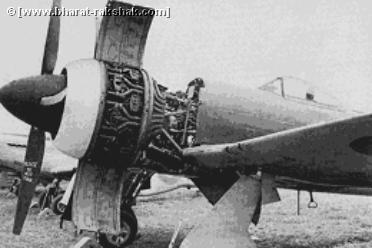 |
The 24 cylinder sleeve valved radial Centaurus on the Mk II. Pic courtesy: The Hawker Tempest page. |
In the event however, the Mk V became ready to fly long before the earlier marks and flew first on 02 Sep 42. The Tempest I flew on 24 Feb 43 but was axed along with the Griffon powered versions in favour of the Mk V and II whose Centaurus engine was showing great promise on the Tornado test bed. While great effort was being put into the Mk V, it was only considered as an interim version, with the Mk II being the ultimate Tempest. The Mk II prototype, LA 602 ultimately flew on 28 Jun 43 with a Typhoon style fin and rudder. Serious engine vibration was soon apparent and was to be the Mk IIs main problem throughout. The answer to the vibrations called for the original eight point rigid mounting to be replaced by a six point rubber mounting and fine balancing of the four bladed prop.
| The prototype Tempest II LA 602 with the Typhoon fin and rudder. Picture courtesy: The Typhoon &Tempest Story by Chris Thomas & Christopher Shores. | 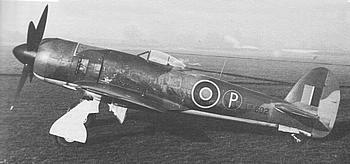 |
The second Mk II, LA 607 flew on 18 Sep 43 with the definitive and more elegant faired-in fin and rudder. The aircraft now enjoyed lighter ailerons thanks to new spring tabs but further engine problems including overheating, exhaust malfunction, crankshaft lubrication and reduction gear seizure combined to delay entry into service further.
When it did arrive at the Armament and Aircraft Experimental Establishment, (A&AEE) Boscombe Down, it was found that it was faster than the Mustang, Spitfire, Bf 109 and the FW-190 below 20,000′. It could just be out-turned by a Mustang and more easily by the Spitfire but could match the 190 and out-turn the 109 which was embarrassed by its leading edge slots which operated near the stall. The Tempest suffered most in its roll rate and the Air Fighting Development Unit (AFDU) concluded that the Tempest and the Spitfire XIV were so different that only Typhoon pilots should be allowed to convert to the Tempest and Spitfire pilots to later marks of the Spitfire. However, only three Typhoon units ever converted to the Tempest in the RAF. Surprisingly in the IAF only Spitfire pilots converted to the type, either from the Mk VIII, XIV or the T Mk IX when the Tempest was used in the fighter conversion role. The first production Tempests II came off the Bristol lines at Banwell only in Feb 45 by which time it had already been selected for use in South East Asia – to replace the RAF’s ageing Hurricanes and lease-lend Thunderbolts and as part of ‘Tiger-Force’ against Japan. Tropical trials were carried out at Khartoum in the Sudan by six aircraft in an attractive and unique dark earth and stone camouflage and the trials were declared successful by the end of Aug 45. The first Tempest IIs were received by 13 OTU at Harwell in Jun 45 quickly followed by deliveries to front line squadrons. But with the war in Europe over and in the Pacific, coming to a dramatic close, The Mk IIs coming off production lines went directly to the MUs for storage and the production order was cut back and final production of this version totaled 452. The Mk VI was also produced with the Sabre V engine becoming the fastest Tempest with a top speed of 438 mph. The Tempest’s high cruising speed made it an ideal choice to meet the RAF’s requirement of a high speed tug for its growing fleet of jet aircraft. Eighty Tempest Vs were thus withdrawn and modified into the TT.Mk 5. These Tempests were the last of the type operated by the RAF when the TT.Mk 5 was withdrawn from 233 OCU at Pemberey in Jul 55. It was in the same month that the IAF retired its last TT modified Mk IIs from the Target Towing Flight at ATW Jamnagar.
The Tempest Comes to India.
The first of 180 Tempest IIs were shipped out to Karachi, Drigh Rd’s 320 MU in Dec 45. The first aircraft went to 5 and 30 squadrons RAF at Bhopal in Mar 46 followed by 20 Squadron RAF at Agra and 152 Squadron RAF at Risalpur. As more Tempests were assembled it was the turn of the RIAF squadrons to convert. As was the case at the time, all RAF aircraft were ‘loaned’ to the RIAF and retained their original RAF serials (PR— or MW—).
However, all Tempests operated by the RAF in India were ‘officially’ handed over to the RIAF on 25 Sep 47 and received serials in the ‘HA—“series by early 1948. These numbered 159, including three, PR 548, 804 & 836 transferred in ‘written-off’ condition. 35 of these were handed over to the PAF along with No 1 and 9 Squadrons IAF on 25 Sep 1947. The RIAF received a further 89 Tempests refurbished by Hawker from RAF stocks of 113 held at 20 MU in May 1948 (the remaining 24 were sold to Pakistan). Once the Tempest II was withdrawn from RAF service, India was able to procure 20 more aircraft from RAF MUs which were delivered in two batches from 09 Jul 1951 (12) and 29 Aug 1951 (08) PR 834 becoming the last of 233 Tempest IIs delivered to India of a total 452 produced.
A total of eight IAF squadrons converted to the type. No 3 Squadron was the first to start conversion at Kolar with No 5 Squadron RAF in Sep 1946, when it received a single Tempest II. Flt Lt MPO ‘Mickey’ Blake becoming the first Indian to fly the Tempest II at Poona on 27 Sep 46.
No 8 Squadron followed in Oct 46, No 10 in May 1947, No 7 and 9 in Jun 47 and finally No 1 and 4 squadrons in Jul 47. Tempests also served in the fighter lead-in role alongside Spitfire VIIIs and XIVs with the Conversion and Training Unit (CTU) at Ambala and Hakimpet, and four Tempests served with a Target Towing Flight under the Armament Training Wing (ATW) at Jamnagar until their final retirement in Jul 1955.
The Tea Cup Wars.
On the partition of the erstwhile British India into Pakistan and India on 15 Aug 47, all 565 princely states were given the option to choose which country they would wish to be absorbed into, depending on their geographical and demographic circumstances. Of these, three princely states, Jammu & Kashmir, Junagad and Hyderabad vacillated due to demographic asymmetries although geographic realities for Junagad and Hyderabad made it imperative that they be absorbed into the Indian Dominion. Jammu & Kashmir and Hyderabad however chose to seek independence. The actions leading to the assimilation of these princedoms into India ranged from small showings of force to ‘police actions’ to full scale armed conflict. These actions were later to be called the “tea cup wars” because they were considered the left over loose ends of poor British foreign policy, and were hence linked to the British penchant for tea and the cup alluded to the relatively localized nature of conflict. It was the first time that independent India deployed its forces in defense of its impending sovereignty and the RIAF rose to the occasion like never before. Almost all these actions would not have been possible without the Tempest II.
Junagad.
On partition, His Highness Bahadurkhanji MahabatKhanji, the Nawab of Junagad, threatened to accede to Pakistan even though there was no common border between the state and Pakistan. The RIAF was called- in as a show of force and 8 Squadron deployed with its Tempests from Poona to Khambaliya on 04 Oct 47 and carried out patrols over Junagad state till Dec 47 when it moved back in preparation for deployment in J&K. Only token resistance was met in the form of belligerent state force troopers firing rifles at low flying Tempests. After a plebiscite that overwhelmingly opted for India, the Nawab abandoned his state and fled to Pakistan leaving his Dewan Sir Shah Nawaz Bhutto (father of Zulfiqar Ali Bhutto, later Prime Minister of Pakistan) to control the populace rioting for food and essentials. Bhutto requested the Indian Government to assist and the Indian army was deployed in Feb 48. Junagad became a part of the Indian Union in the same month.
The Tempest’s Finest Hour, The Race to save Kashmir.
Pending the accession decision of the Maharaja HH Hari Singhji of Jammu and Kashmir (J&K), Pakistan and India had entered into a ‘standstill agreement’ to give the princely state some breathing time to decide. However pre empting the decision by the Maharaja and violating the standstill agreement, Pakistani irregular forces invaded the state on 22 Oct 47 in a bid to capture the Kingdom for itself. The local J&K state forces were overwhelmed within a few days and the invading Mujahideen and Lashkar forces stood a days march from the capital Srinagar. At this point the Maharaja of J&K acceded to India on 26 Oct 47 thus allowing India to step in and recover what it could of the shambles. The RIAF began an airlift into the besieged and continuously shelled airstrip at Srinagar with RIAF and Civil Dakotas in an air effort that was to surpass the Berlin airlift several fold in terms of combat air support in the face of constant enemy fire. Even as 200 men of 1st Bn, the Sikh Regt and 161 Brigade counter attacked and pushed the approximately 4000 invaders to a perimeter just out side Srinagar. Most of the IAF’s fighter fleet had converted to the Tempest IIs by then except for No 2 Squadron and most were under strength and understaffed after the partition with some holding only five Tempests with a smattering of Harvards distributed singly amongst the squadrons for continuity training. However, two RIAF Spitfires and a lone Harvard were flown in from the No 1 Services Flying Training School (SFTS) at Ambala, the closest airfield at the time, to provide support to the defenders. Scrounging fuel in jerry cans from the Dakotas landing troops (no fuel was available at Srinagar) the Spitfires flew round the clock strafing the enemy at the gates of Srinagar.
Tempests in the Valley.
On 28 Oct, No 10 Squadron moved four aircraft from Agra to Ambala and a single Tempest staged via Amritsar to carry out recconnaisance west of Srinagar along the road to Kohala. The next day four Tempests attacked enemy forces all along the Srinagar perimeter and around Pattan As these aircraft forward deployed to what was to become No I Advance Landing ground (ALG) at Amritsar, No 7 Squadron under Sqn Ldr SB Noronha moved five Tempests to Ambala on 30 Oct 47. Few days later the two Spitfires based in Srinagar were reinforced by two Tempests of No 10 Sqn. Tempests flew continuous tac/R sorties locating and attacking enemy positions along narrow defiles, deep gorges and thickly wooded hills. On 3 Nov the enemy attacked at Badgam, only few kilometers south of the Srinagar airfield. The onslaught was stopped in the last moment with support of the Spitfires and Tempests of 7 and 10 sqn. The raider’s main position had been identified at Shelatang a village along the road to Baramulla west of Srinagar and on 07 Nov the Indian Army and Air force launched a joint operation that routed the enemy with the main force escaping across the Jhelum at Domel. Although, Baramulla and Uri were re captured, the Indian advance was forced to wait for the precarious supply situation to catch up. The RIAF provided continuous close support and recce effort from Srinagar and Amritsar. Tempests struck at Uri, Rawalkot and Kotli areas and attacked the key bridges at Muzzafrabad and Domel. Flt Lt Ulrich Anthony D’ Cruz was shot down by ground fire and taken POW whilst flying a 7 Squadron Harvard II in this action. He was later awarded the Ashok Chakra class II (later the Kirti Chakra) for his gallantry.
| Flt Lt Dilbagh Singh briefs Plt Offr Umaid, both of 10 Squadron at Amritsar. Note black single letter ID. | 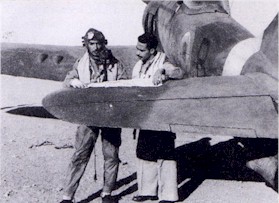 |
RIAF Tempests flew round the clock offensive air support, reconnaissance and interdiction missions. On several occasions the Tempests attacked enemy troops just yards from own troop positions preventing them from being overrun by the overwhelming numbers and firepower. But the cost was high, flying low to make accurate identification, allowed several thousand small arms to be trained on the attacking aircraft and it was seldom that a Tempest returned without damage. Several pilots were injured by ground fire especially later in the war around the enemy stronghold of Tithwal.
Unable to bypass and infiltrate Uri, the invaders opened a second front to the south and captured and held Rawalkot, Bagh, and Rajauri, putting most of Jammu under their control, and by Dec 47 laying siege to Poonch which was to last over a year. In the North West the invaders took the Gilgit agency in Oct 47 and moved south unchecked to capture Gurais and then further south taking Traqbal, 35 miles from Srinagar overlooking the picturesque Wullar Lake. Lacking an airfield close enough to provide close support in the Jammu area, the Army prepared a grass strip at Jammu by Dec 47 allowing 10 Squadron to move in and take part in operations in the Akhnoor-Chammb-Naushera area. No 10s rocketing and strafing Tempests The coming of the extreme winter forced a break in operations for both sides that lasted almost three months. This brought to an end to what was to be later called the “first phase” of the war.
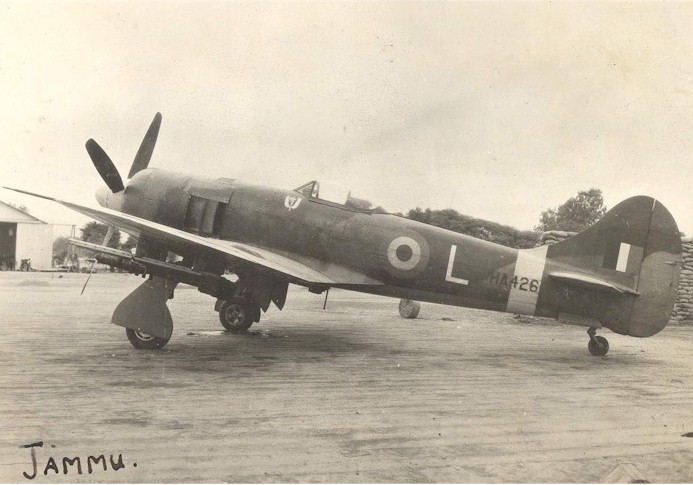 |
|
| HA 426 of No 7 Squadron at Jammu in Dec 48. Note the Battle Axe emblem ahead of the cockpit. Pic courtesy: Air Chief Mshl H Moolgavkar via Jagan Pilarisetti. | |
Jammu airstrip was closed due to the weather and Indian forces concentrated in resupplying and reinforcing several garrisons under siege. The situation was critical in Mirpur and Kotli, both of which were supplied by air-drops of food and ammunition in dozens of missions flown by Dakotas of the No. 12 Sqn, but frequently also by Tempests of No 7 and No 10 Sqns.
The Second Phase.
No 8 Squadron was moved to Jammu on 16 Jan 48 under Sqn Ldr Padam Singh Gill bringing the total fighter bomber strength in the valley to three squadrons with a floating population of an average 20 Tempests and four Harvards. In this second phase of the war both sides (the invaders now being openly supported by regular Pakistan army combatants) dug-in and began to build up for what both sides knew would be the decisive phase for J&K. All through the winter Dakotas, initially ‘air dropping’ and then by landing under howitzer fire at a primitive strip at Poonch, supported Brig Pritam Singh’s besieged garrison. Tempests of 10 Squadron also modified their over load 60 gal drop tanks to drop supplies and ammunition. This operation was later to earn the sobriquet “Mehar Singh’s Operation Poonching” after Air Cmde Mehar Singh, overall commander of air operations in the valley. By early 1948 the Pakistan Army had several small garrisons in Jammu, and especially in the “Gilgit Agency”, Skardu, Aston, and Chilas. Most importantly the enemy had bolstered their anti aircraft defences, quite significantly, by positioning 40mm Bofors and 3.7 in AAA along the valleys after manhandling them up the defiles. The first loss to ground fire was 8 sqn’s Fg offr Amrit Singh Bakshi who lost his tyres and brakes to small arms fire on 29 Jan 48. In the recovery at Jammu the aircraft lost control and somersaulted. Bakshi survived with burn injuries but was invalided from fighter flying.
The Third Phase.
This phase of the Kashmir War came in the spring of 1948. Tempests opened the phase in early Feb 48 by softening targets ahead of 50th Para brigade’s advance on Kot and provided close support at the battle of Naushera, the biggest of the campaign. Exploiting the successes at Naushera, Indian forces pressed towards Jhangar, once again being continuously shepherded by strafing, bombing and rocketing Tempests and recaptured it on 15 Mar 48. On the same day, Fg Offr Donald Michael of 8 Squadron was hit whilst attacking targets at Naushera in PR 749. During the landing at Jammu his damaged port tire disintegrated and the Tempest somersaulted several times before coming to rest on its back and in two pieces. Michael was extricated just in time before the aircraft exploded.
The next day Fg Offr Balwant Singh also of 8 Squadron was shot down and killed by ground fire in PR 597 whilst attacking targets in the same area. Similarly Flt Lt Sardindu Dasgupta of 10 Squadron was lost on take off from Jammu when his aircraft (PR 660) crashed due to engine failure on 22 Mar 48.
RIAF Dakotas of 12 Squadron also unnerved the enemy by rolling out, by hand, 500 lb and 1000 lb bombs from the cabin over enemy troops in the Rungad Nullah area of Poonch. On 23 Apr, 10 Squadron carried out daring raids against the strategic Domel and Kishenganga bridges with several Tempests being damaged by 40mm fire. On one such occasion, Flt Lt JC (Lofty) Plomer operating from Jammu was hit by ground fire which, unknown to him, destroyed his left tire. On landing the ac’s basic tendency to swing to port was magnified ten fold and Flt Lt Plomer was just able to stop the aircraft without nosing over. However, several other pilots suffered serious consequences when they landed with shot away brakes or tyres and ended up on their backs.
On 28 Apr RIAF Tempests led the way to the attack on Traqbal on Wullar lake and continuous rocketing and bombing under difficult weather managed to dislodge the entrenched Frontier Force Rifles, Chitral and Gilgit scouts and regular Pakistan army elements leading to the capture of Tithwal in May and Gurais in Jun 48. On 12 May 48, Fg Offr Derek Austin O Brien was lost in a non combat accident whilst trying to dead stick PR 601 with a stuck throttle at Jammu and Flt lt Aloysius William Barrette of 8 Squadron fatally crashed soon after take off during an air test from Jammu in HA 431 on 08 Aug 48.
The formidable Zoji La was captured on 01 Nov 48 with the ingenuous use of Stuart light tanks of 7 Cav supporting the Gurkhas, Patialas, Rajputs, Marathas and Jats. RIAF Tempests supported 77 Para brigade by strafing enemy dug in positions and mortar nests on either side of the Zoji la defile and beyond with the Tempests having to climb 23,000 ft mountains and flying through valleys with crests 5000′ high. However, in spite of brave attempts to supply the State Force’s Skardu garrison by Tempests, it was overrun on 14 Aug Jul 48. Tithwal was a particularly AAA infested objective and several Tempests were severely damaged in attacks during its capture.
Tempests had to fly through a hail of 40mm fire from both sides of the heights overlooking the approaches to Tithwal and Fg Offr D G Baptiste of 7 Squadron was lost to AAA on 12 Sep 48 in HA 411. He was later awarded the VrC for gallantry during a two month period in which he flew almost 80 missions and was wounded several times.
In the words of Brig Umrao Singh, commanding No 19 Inf Brigade, -“the enemy would undoubtedly have overrun the Indian positions but for the Tempest”. In fact pilots were being directed and congratulated ‘real time’ with the aid of a ‘Visual Control Pilot’ (VCP) who relayed target information from a Tempest, Harvard or Auster to Tempests operating ‘cab rank’ fashion.
The Final Phase.
With the main threat swinging to the North, 7 Squadron was moved up from Amritsar to Srinagar in Aug 48 under Sqn Ldr ED Massilamani with eight Tempests and one Harvard. On 03 Oct 48, 7 Squadron suffered its fourth and last loss near Pandu when Fg Offr UG Wright baled out after being shot down in HA-363. After a harrowing escape and evasion during which he was fired at during the parachute descent he managed to return and link up with Indian troops.
Plt Offr Ivor Patrick Carrapiett, the youngest casuality of the war was declared missing in action when his Tempest HA-416 failed to return from a mission to Chamb on 05 Nov 48. Interestingly, Patrick’s father moved to Karachi in Pakistan after the war to take up a senior position in the Pakistan railway. His younger son joined the Pakistan air force and was at Shorkot Rd (today Rafiqui) during Sqn Ldr ‘Jimmy’ Bhatia’s and Flt Lt Tambay’s (32 Squadron on SU-7s) strike on the airfield on 04 Dec 71. The younger Carrapiett is said to have recovered Tambay’s body and returned his belongings after the war.
Tempests played an equally important role in the strikes against hostiles at Pir Badesar and the dominating Pir Kalewa which finally led to the action enabling the link up with, and relief of the Poonch garrison on 20 Nov 48. Tempests twins alternated with field artillery to keep constant pressure on the enemy and established the location of Pakistani 7th Arty Div’s 25 pounders shelling Poonch, these targets being finally destroyed with rockets. The taking of Ramgarh fort and Pt 6944 on the west flank of Bhimbar Gali was to be a classic close support action with Indian forces carrying out a final bayonet charge against the enemy trenches whilst Tempests strafed and rocketed the trenches at close quarters. On a chance reconnaissance, enemy airfields were located at Gilgit and 40 NMs south, at Chilas. Tempests flew several strikes against the landing strips in Oct and Nov 48, cratering & damaging both and destroying several hangars, barracks and radio installations. This attack destroyed Pakistani plans to build an offensive air capability in the North. Already, with Tempests prowling the valleys, Pakistani re supply by Dakotas had been limited to hazardous night flying through the valleys. With the war shifting to the northeast, 10 Squadron the first to move into the theater was relieved and moved to Palam in Oct 48. In Oct and Nov 48, 8 Squadron joined with 7 Squadron at Srinagar to launch large formations to strike Bagh and the old and newly built forts at Skardu. The fort at Skardu was attacked on several occasions as also the Pir’s house at Rondu with satisfying results. These missions were flown over arctic conditions with normal temperate clothing worn by the pilots leaving little chance for survival in case a pilot was forced to abandon his ac. Sorties called for negotiating the 26,000′ mastiff of the Nanga Parbat .
Towards the south-east, 77 parachute brigades advance on Kargil and Dras, which had been captured by the enemy in May was continuously supported by Tempests in Nov 48 until the Gurkhas in the Leh garrison were firmly linked on 24 Nov 48. With both sides becoming increasingly exhausted and reaching a stale mate in the west, a UN enforced cease fire was agreed to from midnight, 31 Dec 48, with the Line of Control (LOC) becoming the de-facto border. RIAF Tempests continued to carry out reconnaissance over the troubled areas near Jammu with occasional strafing to dissolve any build up of offensive activity especially at Bagh and Kotli. The last major action was the concentrated enemy shelling of Naushera with nearly 5000 shells being lobbed into these confines in less than eight hours. Patrolling 7 Squadron Tempests also encountered heavy AAA fire around these areas for the last time on 14 Dec 48. The last targets attacked by mostly 7 Squadron Tempests were the bridge at Hajira and troop concentrations at Palak and Sadabad in the last week of the war. Thus ended India’s first military action post independence.
The Tempest Gallant.
Of a total 29 (plus one Ashok Chakra second class to Flt Lt Ulrich Anthony D’ Cruz of 7 Squadron on Harvard II.) gallantry awards awarded for action during the 47-48 operations, 16 went to Tempest crew and the rest to the equally courageous Dakota crew and one to a Spitfire pilot of the Advanced Flying School. This was the first time that gallantry medals promulgated by an independent India were awarded. However, as the action commenced soon after independence it took a little while for the awards to be thought out, designed and passed by government. Hence it was only 1949 by the time these awards were in place and most of the awards were promulgated on 26 Jan 1950, the day India moved from dominion to republic status. Six further awards were announced on 20 Nov 50 and one last MVC to Wg Cdr H Moolgavkar on 08 Dec 51
| Maha Vir Chakra: A total four MVCs were awarded of which three went to Tempest pilots. They were:
Wg Cdr Minoo Merwan Engineer |
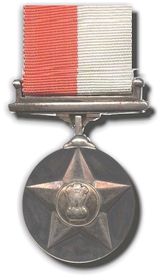 |
| Vir Chakra: A total of 25 VrCs were awarded of which 15 went to Tempest crew and one to a Spitfire pilot, Flt Lt Leslie Richard Dickinson Blunt. They were:
Wg Cdr Ranjan Dutt |
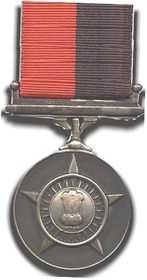 |
| Click on the names to view complete citations. Courtesy of Air Marshal Bharat Kumar | |
Skirmish on the Deccan, Operation Polo.
Even as Pakistan and India fought over the accession of the J&K kingdom in the north, the Nizam of Hyderabad Dominion, Nawab Mir Osman Ali Khan attempted to carve out an independent state from the ruins of the Mughal Empire on the Deccan plateau in central India. Threatening retaliation with some 22,000 state troops and a purported 200,000 irregular Razakar volunteers, he began attacking Indian union villages outside his state and attempted to involve the Pakistani military and the UNO. Unable to accept further intimidation and to prevent a Kashmir like stalemate, the Indian Union launched a police action to assimilate the Hyderabad princely state into the Indian union.
This operation was planned by Lt Gen EN Goddard GOC-in-C southern command with overall command with Lt Gen Rajendrasinghji, DSO and came to be known as Operation Polo.
No 3 Squadron under Sqn Ldr KS Bhat was moved from Cawnpore to Poona to support the western thrust while No 4 Squadron under Sqn Ldr Ghisad moved from Cawnpore to Gannavaram airstrip, located on the outskirts of Vijaywada in the east. The Indian Ist Armoured Div attacked from Vijayawada in the East and Sholapur in the West with action commencing at 0400 on the 13 Sep 48. A small Forward Air Control Team (FACT) was attached to Skinner’s Horse and 9 Dogras under Lt Col Ram Singh attacking along the Sholapur-Secunderabad axis. Both squadrons had commenced flying regular air recce sorties from July 48 onwards.
On the first day-13th Sep- two Tempests from 4 Squadron struck Warangal airfield whilst an enemy parade was on. The duo damaged the strip with 1000 lb bombs and strafed a light aircraft. On the 14th two 3 Squadron Tempests were called out from Poona at last light to engage hostiles at Hospet and Tungu bridge. On the return one aircraft ran out of fuel and the pilot bailed out while the other crashed while diverting at an unlit Sholapur airfield. On the second day, 3 Squadron was called in on the 14th to rocket Razakars harassing Maj Gen JN Chaudhuri’s 5/5 Gurkhas attempting to cross an 8 Km defile near Talmud on their advance to Rajasaur. The Razakars retreated after a few rockets and Rajasaur and then Kalyani were taken by nightfall.
4 Squadron was called into soften Suriapet town held by elements of the Hyderabadi 3 Golconda Lancers on the morning of the 15th. The 2/5 Gurkhas then rapidly mopped up the remaining Hyderabad forces. Tempests from the unit strafed the airstrip at Warangal town and subsequently at Hakimpet, while 3 Squadron from the west bombed Bidar using both Tempests and Harvards, an action that assisted the taking of Bidar in the early hours of the 17th Sep. Tempests attacked Hakimpet airfield on the afternoon of the 17th and Indian Union forces entered Secunderabad and Bolarum the next day at 1600 hrs accepting the surrender of the Arab commander Maj Gen El Edroos, bringing to an end what was to be called the 100 hrs war. Hyderabad state finally acceded to the Indian Union on the 24th Nov 48.
Keeping The Peace & Retirement.
With the end of the teething troubles of partition and independence, the Tempest squadrons settled into their peace time stations at Palam and Poona. However, engine troubles continued to claim aircraft and lives and the skill required to land the Tempest continued to cause several write offs. The arrival of the Jet engined Vampire were the first signs of the Tempest’s demise. As the IAF began a rapid expansion to an all jet force, several Tempest squadrons began converting to Vampires, 7 Squadron being the first in Dec 49. By this time it had already been decided that the Tempest would be relegated to the fighter lead-in role to train pilots for the new jet fighters. A conversion training flight was set up at Ambala in Sep 49 with Spitfire T Mk IXs, XVIIIs and Tempests to provide 16 hrs/six weeks of supervised Tempest training. This unit eventually moved to Hakimpet two years later and operated till the end of 1952. The brute power of the Tempest and its impressive air to ground firing demonstrations continued to impress crowds but it was also by then, known that the significant spares and engine problems would mean withdrawal of the type earlier than expected and by late 1952 only 10 & 4 squadrons operated the type at Halwara and Poona. 4 Squadron became the last operational unit on the type when it handed over its Tempests for Vampires in Apr 54. The Tempest claimed its last life on 28 Apr 54 when Plt Offr PN Bali lost the engine soon after take off and crashed with full armament load at the end of RW 27 at Poona. Several of these last Tempests included HA 559,569,604,609,611,614, 632 and 635.
Four of these aircraft were requisitioned in mid 1954 to form a Target Towing Flight with the modification of an underbelly hook at ATW Jamnagar and were designated the Tempest IIA. The flight operated for a year and was decommissioned in Jul 55 bringing to an end the era of the Tempest. Most Tempests languished outdoors at Cawnpore, exactly where the story of the Indian Tempests began in 1946, until sold as scrap in the mid 60s. Many 4 Squadron machines lay in the grass of Poona until purchased by European and American restorers in the 70s and one machine, HA 623 (MW 848) survives at the Air Force museum today.
True to its name, the Tempest was a strong influence on the IAF; it played a pivotal role in India’s first conflict, held everyone’s attention with its power, fury and angry temperament and vanished from the scene as soon as it had come. In its wake, it left the IAF a feel of its first ‘heavy fighter’ and laid the bedrock of battlefield interdiction and battlefield air support tactics for the future.
